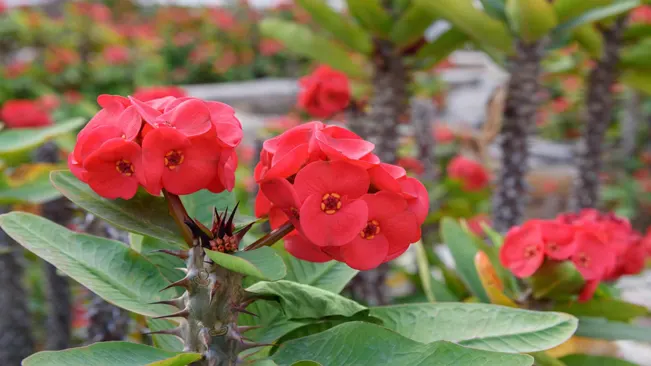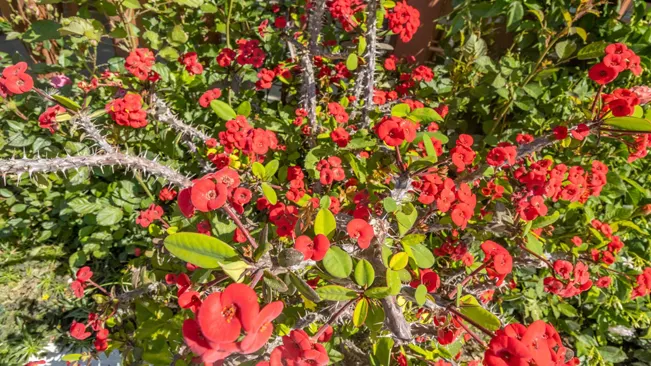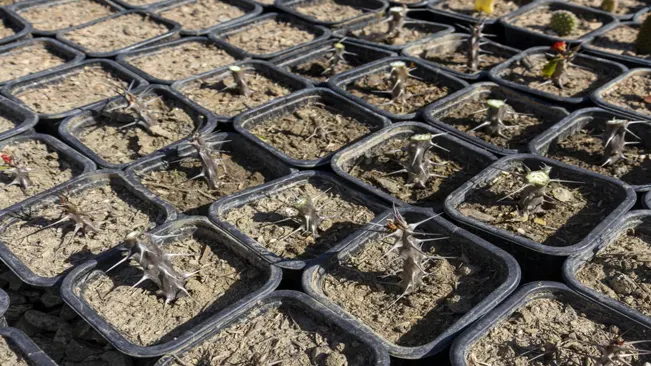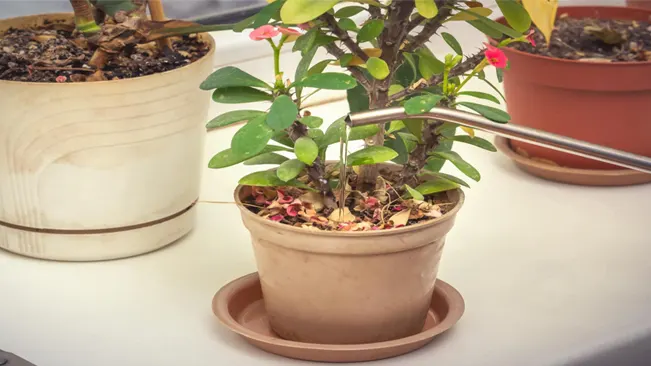How to Grow Crown of Thorns: Complete Guide from Planting to Flourishing
- April 3, 2024
- 0 comment
The Crown of Thorns, scientifically known as Euphorbia milii, is a fascinating and resilient flowering plant, revered for both its striking appearance and its historic and symbolic significance. Native to Madagascar, this drought-tolerant succulent is well-suited for indoor and outdoor cultivation, making it a favorite among gardeners seeking a low-maintenance yet visually appealing plant.

List on How To Grow Crown of Thorns
- Selecting the Right Environment
- Planting and Soil
- Watering Practices
- Fertilization
- Pruning and Maintenance
- Pest and Disease Management
- Safety Precautions
Selecting the Right Environment
Light Requirements
The Crown of Thorns plant is particularly adaptable when it comes to light. Its preference for bright light makes it an excellent choice for locations that receive a lot of sunlight.

- Indoor Growing: When kept indoors, it’s crucial to place the plant near a window that allows for plenty of direct sunlight. South-facing windows are often recommended as they tend to receive the most sunlight throughout the day. East or west-facing windows can also work well, providing the plant with at least a few hours of direct sunlight.
- Outdoor Growing: If you’re growing Crown of Thorns outdoors, choose a location where it will receive full sun for the majority of the day. This plant is quite adaptable to varying levels of sunlight but thrives in direct sun. Partial shade is also acceptable, especially in regions with very intense midday sun, as it can help prevent leaf scorch.
Temperature and Humidity
Crown of Thorns plants prefer a warm environment, which aligns with their native tropical and subtropical habitats.
- Optimal Temperature Range: The ideal temperature range is between 60°F and 90°F (15°C and 32°C). This range supports healthy growth and flowering. It’s important to keep the plant in an environment where nighttime temperatures don’t drop significantly below the daytime temperatures.
- Tolerance to Lower Temperatures: While the plant can tolerate cooler temperatures down to about 50°F (10°C), it’s important to avoid prolonged exposure to these lower temperatures, as it can lead to stress and damage to the plant. If you live in a cooler climate and have your Crown of Thorns outdoors, consider bringing it inside during the colder months.
- Humidity Requirements: The Crown of Thorns isn’t particularly demanding when it comes to humidity. It can tolerate a range of humidity levels, but moderate humidity is ideal. If your indoor air is very dry, particularly in winter when heating systems are used, consider using a humidifier or placing a water tray near the plant to increase humidity. However, avoid misting the plant directly, as this can increase the risk of fungal diseases.
Planting and Soil
Soil Composition
Crown of Thorns (Euphorbia milii) is a succulent plant, and like most succulents, it’s particularly susceptible to root rot caused by excessive moisture around its roots. Therefore, well-draining soil is not just a preference; it’s a necessity for its survival and health.

Ideal Soil Mix
- Cactus or Succulent Mix: These commercial mixes are formulated to mimic the natural, arid environments succulents thrive in. They typically contain a blend of organic and inorganic materials that provide both nutrients and proper drainage.
- DIY Blend: For a more customized soil, mixing equal parts of potting soil, perlite, and sand creates an excellent, well-draining medium.
- Potting Soil: Offers nutrients and a bit of moisture retention.
- Perlite: A volcanic glass that’s been heated and expanded, perlite improves aeration and drainage.
- Sand: Coarse sand (not fine beach sand) aids in drainage and prevents the soil from becoming too compact.
Potting and Repotting
Choosing the Right Pot

- Drainage Holes: The pot must have drainage holes at the bottom. These are critical for allowing excess water to escape, preventing water from accumulating at the bottom of the pot, which could cause root rot.
- Material: Pots made of porous materials like terracotta or clay can be beneficial as they allow for more evaporation of moisture from the soil, compared to plastic or glazed ceramic pots.
Repotting Process
- When to Repot: Typically, repotting is necessary every two to three years. It’s time to repot when you notice the plant outgrowing its current container, either visibly or when roots start to come out of the drainage holes.
- Steps for Repotting:
- Preparation: Water the plant a day before repotting to minimize stress.
- Removing the Plant: Gently remove the plant from its current pot, being careful not to damage the roots.
- Root Inspection: Check the roots for signs of rot or disease. Trim any damaged roots.
- New Pot: Select a new pot that is slightly larger than the current one. Fill the bottom with a layer of the soil mix.
- Repotting: Place the plant in the new pot and fill around it with more soil, ensuring it’s positioned at the same depth it was in the old pot. Don’t pack the soil too tightly.
- Aftercare: Water the plant lightly after repotting and keep it in a shaded area for a few days to recover.
Watering Practices
Crown of Thorns is a succulent, meaning it’s adept at storing water in its stems and leaves. This adaptation allows it to thrive in dry, arid environments and makes it less demanding in terms of watering compared to many other plants.

- Checking Soil Moisture: Before watering, it’s essential to check the soil moisture. The top inch of the soil should be dry to the touch. If it’s still moist, delay watering.
- Water Deeply but Infrequently: When you do water, do so thoroughly, allowing water to run through the drainage holes of the pot. This ensures that the roots receive moisture, but it’s crucial not to leave the plant in standing water.
- Seasonal Adjustments: Watering frequency should be adjusted according to the seasons. During the plant’s active growing period in spring and summer, it may require more frequent watering. In contrast, in fall and winter, the plant enters a dormant stage and requires less water.
- Indoor vs. Outdoor Watering: If your Crown of Thorns is outdoors in a hot climate, it may need more frequent watering compared to an indoor plant. Always check the soil moisture level as a guide.
- Signs of Overwatering: Yellowing leaves or a mushy stem are signs of overwatering and potential root rot. If you notice these signs, reduce your watering frequency.
- Signs of Underwatering: While the Crown of Thorns tolerates dry conditions, prolonged under-watering can lead to drooping or shriveling leaves.
Fertilization
Crown of Thorns is a relatively low-maintenance plant when it comes to fertilization. It doesn’t require as much feeding as some other houseplants because it’s adapted to grow in less fertile conditions. However, appropriate fertilization can help in promoting healthier growth and more vibrant blooms.
Choosing the Right Fertilizer
- Type: A balanced, water-soluble fertilizer is ideal. The term “balanced” means it has equal parts of the primary nutrients: nitrogen (N), phosphorus (P), and potassium (K). Look for a fertilizer with a ratio like 10-10-10 or 20-20-20.
- Water-Soluble: These fertilizers are easily dissolved in water and allow you to feed the plant while you water. This method helps in distributing the nutrients evenly around the root system.
Diluting the Fertilizer
- Half-Strength: It’s crucial to dilute the fertilizer to half the strength recommended on the package. Crown of Thorns is sensitive to over-fertilization, which can lead to root burn or excessive salt buildup in the soil. Diluting the fertilizer reduces the risk of these problems.
- Mixing Instructions: If the label suggests using one tablespoon of fertilizer per gallon of water, use only half a tablespoon for the Crown of Thorns.
Fertilization Schedule
- Growing Season: Fertilize once a month during the spring and summer months. This is when the plant is actively growing and can make the most use of the additional nutrients.
- Non-Growing Season: Refrain from fertilizing in the fall and winter. During these cooler months, the plant’s growth slows down, and it requires fewer nutrients. Continuing to fertilize in this period can harm the plant.
Pruning and Maintenance

Understanding Pruning for Crown of Thorns
- Purpose of Pruning: Pruning is mainly done to maintain the desired shape of your plant, remove any unhealthy parts, and encourage bushier, more vigorous growth. It can also help in controlling the size of the plant, making it suitable for indoor spaces.
- Best Time to Prune: The ideal time to prune your Crown of Thorns is in the late winter or early spring, just before the growing season begins. However, small, corrective prunings can be done any time of the year if necessary.
Steps for Pruning
- Preparation: Wear thick gloves to protect your hands from the plant’s spines and toxic sap. Using clean, sharp pruning shears or scissors is crucial to make clean cuts and prevent damage to the plant.
- Identifying Where to Cut: Look for leggy stems, overgrown areas, or any dead or unhealthy-looking parts of the plant. Your goal is to create a balanced, aesthetically pleasing shape while encouraging new growth.
- Making the Cut: Make your cuts at a 45-degree angle about a quarter-inch above a leaf node (the point where leaves emerge from the stem). This encourages new branches to grow from the cut point.
- Dealing with Sap: If you get sap on your skin, wash it off immediately with soap and water to avoid irritation. Be mindful not to touch your face or eyes during the pruning process.
Post-Pruning Care
- Cleaning Up: Dispose of the cuttings properly. Since the sap is toxic, ensure they are out of reach of children and pets.
- Watering After Pruning: Water the plant as you normally would after pruning. Avoid overwatering, as the plant may be more susceptible to root rot, especially after losing some of its foliage.
- Observing for New Growth: In the following weeks, you should start seeing new growth at the sites of the cuts. This indicates a healthy response to pruning.
Pest and Disease Management
Pest Management
- Spider Mites: These tiny pests are often hard to spot until significant damage has occurred. They cause yellowing or bronzing of the leaves and may leave fine webs. To combat spider mites, isolate the infected plant, increase humidity around it, and use neem oil or insecticidal soap. Regularly wiping the leaves with a damp cloth can also prevent their occurrence.
- Mealybugs: These are small, white, fluffy insects typically found in clusters in leaf axils, on stems, or under leaves. They suck sap from the plant, weakening it and causing stunted growth. You can remove mealybugs manually using a cotton swab dipped in rubbing alcohol, or treat the plant with neem oil or insecticidal soap.
- Aphids: Small and often green, aphids usually gather on new growth or under leaves. They can cause leaf curling and stunted growth. Aphids can be blasted off with a water hose, or you can use neem oil, insecticidal soap, or a strong jet of water to control them. Introducing beneficial insects like ladybugs can also help.
Disease Management
While Crown of Thorns is relatively resistant to diseases, they can still be affected, particularly by fungal issues related to overwatering.
- Root Rot: This is the most common problem, often due to overwatering or poor drainage. Symptoms include yellowing leaves, soft brown roots, and a general decline in health. To prevent root rot, ensure the soil is well-draining and let the soil dry out between waterings. If root rot occurs, you may need to repot the plant, trimming away any rotten roots.
- Fungal Infections: Fungal infections can occur in overly moist environments. Good air circulation, less frequent watering, and avoiding getting water on the leaves can prevent these issues. Fungicidal sprays can be used as a treatment for severe cases.
Safety Precautions
Handle with care! The plant’s sap is toxic if ingested and can irritate the skin and eyes. Keep it out of reach of children and pets.
Understanding the Toxicity
- Sap Composition: The sap of Crown of Thorns contains compounds that are irritating to the skin and mucous membranes. It’s a milky-white liquid that can be released when the plant is cut or broken.
- Ingestion Risks: If ingested, the sap can cause irritation to the mouth, throat, and stomach, leading to symptoms like nausea, vomiting, and diarrhea. In severe cases, it can cause more serious health issues.
Skin and Eye Contact
- Skin Irritation: Direct contact with the sap can lead to dermatitis, which is characterized by redness, itching, and rash. Some individuals may experience more severe reactions depending on their sensitivity.
- Eye Exposure: If the sap gets into the eyes, it can cause severe pain, redness, and swelling. Immediate flushing of the eyes with plenty of water is necessary.
Handling Precautions
- Wearing Protective Gear: When handling the plant, especially during pruning or repotting, wear gloves and, if necessary, protective eyewear. This will help avoid direct contact with the sap.
- Careful Pruning: Use tools specifically for gardening, and be cautious to avoid breaking the stems unnecessarily, which can release the sap.
- Washing Hands: Always wash your hands thoroughly after handling the plant, even if you wore gloves.
Placement and Accessibility
- Out of Reach of Children and Pets: Due to its toxicity, place the Crown of Thorns where children and pets cannot easily access it. This is particularly important for households with curious pets or young children who might touch or ingest the plant.
In Case of Exposure
- Skin Contact: If sap contacts the skin, wash the area with soap and water immediately. If irritation persists, seek medical advice.
- Eye Contact: Rinse the eyes immediately with water for several minutes and seek medical attention if discomfort continues.
- Ingestion: If the sap is ingested, do not induce vomiting. Rinse the mouth and drink water to dilute. It’s important to seek medical help promptly.
Related Growing Guides:
Conclusion
The Crown of Thorns, with its unique appearance and relatively simple care requirements, is a fantastic addition to any plant collection. By following these guidelines, you can enjoy the beauty and resilience of this remarkable plant for years to come.
FAQs (Frequently Asked Questions)
- What kind of light does Crown of Thorns need?
- Crown of Thorns thrives in bright, direct sunlight. If grown indoors, a south-facing window is ideal. Outdoors, it prefers full sun to partial shade.
- Crown of Thorns thrives in bright, direct sunlight. If grown indoors, a south-facing window is ideal. Outdoors, it prefers full sun to partial shade.
- How often should I water my Crown of Thorns?
- Water the plant when the soil is completely dry. This may vary from once a week to once every few weeks, depending on the climate and indoor conditions. Overwatering can lead to root rot, so it’s better to underwater.
- Water the plant when the soil is completely dry. This may vary from once a week to once every few weeks, depending on the climate and indoor conditions. Overwatering can lead to root rot, so it’s better to underwater.
- Do I need to fertilize my Crown of Thorns?
- Yes, but sparingly. Fertilize with a diluted, balanced fertilizer once a month during the growing season (spring and summer). Avoid fertilizing in the fall and winter when the plant is dormant.
- Yes, but sparingly. Fertilize with a diluted, balanced fertilizer once a month during the growing season (spring and summer). Avoid fertilizing in the fall and winter when the plant is dormant.
- Is Crown of Thorns suitable for indoor growing?
- Yes, it’s an excellent indoor plant as long as it receives enough light. Ensure it’s placed in a bright spot, such as near a sunny window.
- Yes, it’s an excellent indoor plant as long as it receives enough light. Ensure it’s placed in a bright spot, such as near a sunny window.
- How do I repot Crown of Thorns?
- Repot in the spring every two to three years. Use a well-draining soil mix and a pot with drainage holes. Be careful of the plant’s spines and sap during repotting.
- Repot in the spring every two to three years. Use a well-draining soil mix and a pot with drainage holes. Be careful of the plant’s spines and sap during repotting.
- Can Crown of Thorns tolerate cold temperatures?
- It prefers warm temperatures and should not be exposed to temperatures below 50°F (10°C) for extended periods. It’s not frost-tolerant and should be brought indoors in cooler climates during winter.
- It prefers warm temperatures and should not be exposed to temperatures below 50°F (10°C) for extended periods. It’s not frost-tolerant and should be brought indoors in cooler climates during winter.
- How do I prune Crown of Thorns?
- Prune to shape the plant or remove any leggy growth. Always use gloves, as the sap can be irritating to skin and eyes.
- Prune to shape the plant or remove any leggy growth. Always use gloves, as the sap can be irritating to skin and eyes.
- What are common pests and how do I deal with them?
- Common pests include aphids, spider mites, and mealybugs. Treat infestations with insecticidal soap or neem oil.
- Common pests include aphids, spider mites, and mealybugs. Treat infestations with insecticidal soap or neem oil.
- Why are the leaves on my Crown of Thorns falling off?
- Leaf drop can be caused by overwatering, underwatering, or a significant change in lighting or temperature. Assess your care routine to identify and correct the issue.
- Leaf drop can be caused by overwatering, underwatering, or a significant change in lighting or temperature. Assess your care routine to identify and correct the issue.
- Is Crown of Thorns toxic?
- Yes, the sap is toxic and can cause skin irritation and is harmful if ingested. Handle with care and keep away from pets and children.

Kristine Moore
Forestry AuthorI'm Kristine Moore, a seasoned garden landscaping professional with over 30 years of experience. My extensive career has been dedicated to transforming outdoor spaces into stunning, sustainable landscapes. With a deep understanding of horticulture, design principles, and environmental stewardship, I have become a respected figure in the field, known for creating harmonious, visually appealing, and eco-friendly gardens. My commitment to excellence and continuous learning in landscaping trends and techniques has solidified my reputation as an expert in garden design and implementation.













Leave your comment